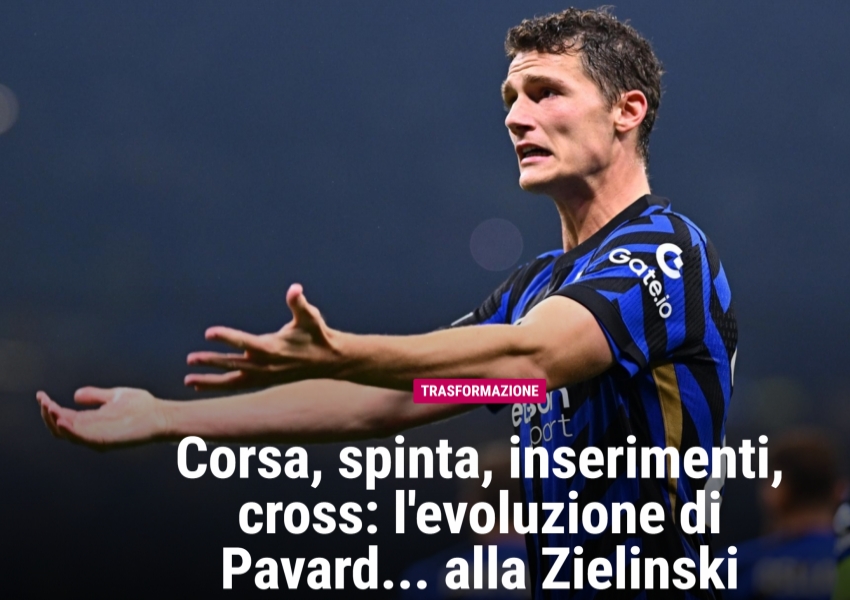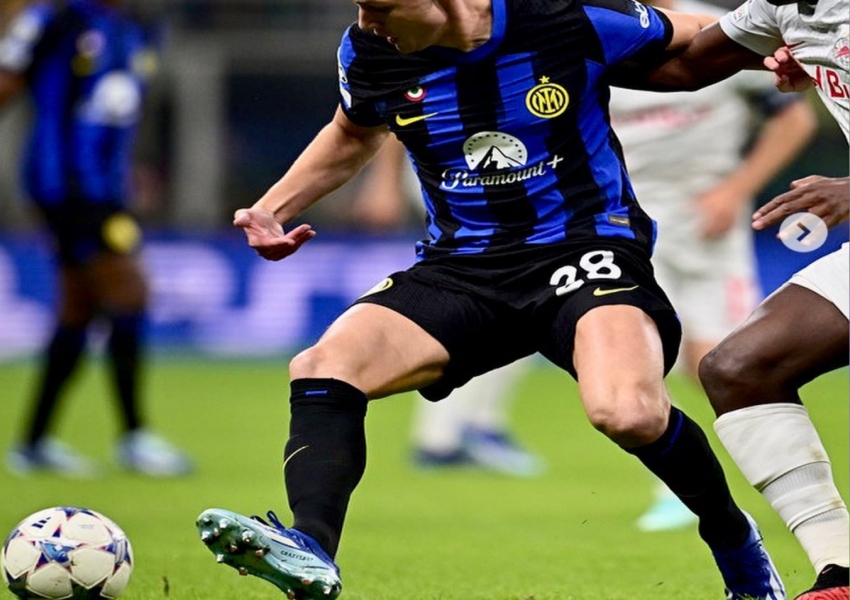Pavard’s Evolution at Inter: Key Stats in Just Six Games Already Match His Entire 2022-23 Season – But Why Is He Left Out of the French Squad?
Benjamin Pavard’s recent exclusion from the French national team has sparked significant debate, particularly as his performances for Inter Milan in the 2023-24 season continue to impress. Despite racking up important minutes and contributions for Inter, Didier Deschamps left Pavard out of his latest squad, citing multiple reasons. While some believe personal friction between Pavard and Deschamps has played a role, others argue that technical reasons related to Pavard's style of play and his fit within the national team’s system have been the true cause.

This controversy arises as Pavard has already matched key stats from his entire previous season at Inter in just six games, showcasing a significant evolution in his game. Despite these impressive performances, his exclusion from France raises important questions about tactical suitability and the changing demands placed on the versatile defender.

Deschamps' Explanations – Genuine or Just Excuses?
When asked about Pavard’s absence, Deschamps gave two reasons. Firstly, he expressed a desire to test out other players. Secondly, Deschamps pointed out Pavard's inconsistent playing time at Inter Milan, suggesting that he had not been a regular starter. This second claim, however, does not stand up to scrutiny when examining the data. Pavard has played 466 minutes across all competitions for Inter so far this season, ranking him higher in playing time than key players like Lautaro Martinez (449 minutes) and Nicolo Barella (402 minutes). Clearly, Pavard has been an important figure in Simone Inzaghi’s squad, which raises doubts about Deschamps’ reasoning.

The real reason behind Pavard’s exclusion may lie elsewhere. Many believe that Deschamps simply doesn’t see Pavard fitting into France’s current tactical setup, particularly the 4-man defensive line. Pavard’s evolving playing style at Inter has seen him become less compatible with Deschamps' demands for the national team, which prioritizes different attributes in defenders.
Pavard’s Evolution at Inter: The “Four More” Revolution
The Italian press, particularly La Gazzetta dello Sport, has emphasized Pavard’s evolution under Simone Inzaghi’s system, describing it as a “transformational change.” This transformation is supported by key statistical data that points to four significant areas of improvement: more running, more advanced positioning, more late runs into the box, and more involvement in attacking plays.
More Running
Pavard’s work rate remains consistent with his previous season, covering roughly 10 kilometers per game. However, the nature of his running has evolved. His sprint speed, in particular, has seen a noticeable uptick. Last season, his top speed hovered around 32.2 km/h, but this season, Pavard has already hit 33.08 km/h. This increase in explosive pace has allowed him to contribute more effectively to both defensive recoveries and attacking plays.
More Advanced Positioning
A defining aspect of Pavard’s evolution is his positioning on the pitch. Last season, Pavard averaged 80.3 touches per game, with 8.26 of those occurring in his own penalty area and 34.7 in the defensive third. These two areas accounted for 53.5% of his total touches. However, in the current season, Pavard's touches have shifted further upfield. He now averages 77.7 touches per game, but only 7.69 are in his own box, and 28.7 are in the defensive third, meaning just 46% of his touches are in the defensive zones. This significant shift reflects a more advanced role, with Pavard contributing to Inter's attacks and supporting the midfield more frequently than before.
More Late Runs into the Box
Pavard’s attacking threat has also increased, particularly in terms of late runs into the opposition box. In his 23 Serie A appearances last season, Pavard had nine opportunities to shoot from inside the opponent’s penalty area, averaging 0.4 shots per 90 minutes. This season, that figure has risen to 0.67 per 90 minutes, indicating a greater willingness to join attacks and take on shooting opportunities.
More Involvement in Attacking Plays
Pavard’s dribbling stats further illustrate his growing involvement in Inter’s offensive play. Last season, he averaged 48.6 dribbles per game, covering a total distance of 234.4 yards, with 118.2 yards representing forward progression. His dribbles into the attacking third averaged 1.23 per game. In contrast, this season, Pavard is averaging 53.3 dribbles per game, covering 311.3 yards overall, including 176.9 yards of forward progression. His average number of dribbles into the attacking third has also increased to 1.92 per game. These stats highlight Pavard’s growing role as an attacking threat, with Inter encouraging him to push forward and support the front line.
Why Pavard's New Style Doesn’t Fit Deschamps' France
While Pavard’s evolution at Inter has been positive for his club performances, it may have contributed to his exclusion from the French national team. Under Deschamps, France operates with a traditional back four, requiring defenders to be highly disciplined, defensively solid, and positionally aware. Pavard’s increasing involvement in advanced areas and his more attacking mindset may not align with Deschamps’ vision of a balanced defense.
Deschamps has preferred to rely on more conventional full-backs, such as Jonathan Clauss of Lille, who at 32 has proven to be a reliable and steady presence on the right side of the defense. Clauss' performances in Ligue 1 this season include one goal and two assists in the first six rounds, highlighting his consistency in a more defensive role. His style is in stark contrast to Pavard’s more adventurous and attacking approach at Inter.
Pavard’s Defensive Trade-offs
With Pavard pushing further forward and taking on a more attacking role, there have been trade-offs on the defensive side. Several football analysts, including those on platforms like Twitter and dedicated Inter forums, have raised concerns about Pavard’s defensive solidity this season. Some point to his core strength as a possible issue, arguing that Pavard lacks the physical presence needed to compete against Europe’s most powerful forwards.
Interestingly, Pavard faced similar criticisms last season, but he still managed to establish himself as one of Inter’s most difficult defenders to beat in 1v1 situations. However, when a defender is tasked with advancing high up the pitch and covering greater distances, it’s natural for their defensive effectiveness to decline due to fatigue or positional lapses. This may explain why Pavard’s defensive performances have come under scrutiny this season.
A Tactical Mismatch for France?
The real question is whether Pavard’s current style of play suits Deschamps’ tactical setup for France. Previously, Pavard was competing for a central defensive role in France’s backline, but with his evolving game at Inter, he now finds himself competing for a spot as a full-back. This is a significant shift, especially when considering the wealth of talent France has in the full-back position. French full-backs are known for their speed, athleticism, and attacking prowess, with players like Theo Hernandez, Jules Kounde, and Ferland Mendy all offering elite qualities.
France has an abundance of options in these positions, many of whom possess qualities that make them more natural fits for Deschamps’ system. Pavard’s newfound attacking freedom may work against him in this context, as Deschamps is likely looking for full-backs who can maintain a balance between defense and attack, rather than someone who has become more of an offensive weapon.
In this sense, Pavard may be a victim of his own success at Inter. His “evolution” has made him more of a hybrid player, capable of influencing the game in both defense and attack. However, this has also placed him in a difficult position for national team selection, as Deschamps may view him as neither a top-tier center-back nor a fully traditional full-back.
A Setback for Pavard but a Boost for Inter?
While Pavard’s exclusion from the French squad is undoubtedly a personal blow, it may ultimately benefit Inter. With a grueling club schedule ahead, including Serie A and Champions League fixtures, Pavard’s presence at Inter without the added burden of international duty could prove advantageous for Simone Inzaghi’s side. If Pavard can continue his strong form and further refine his role in Inter’s system, his “evolution” may ultimately make him one of the most important players for the Nerazzurri.
In the end, Pavard’s transformation at Inter represents a fascinating case of a player adapting to a new style and role under a different tactical system. While this has temporarily cost him his place in the French national team, it could pay dividends for both his individual career and Inter Milan in the long run.
Copyright Statement:
Author: mrfootballer
Source: Mrfootballer
The copyright of this article belongs to the author. Reproduction is not allowed without permission.
Recommended Blog
- Premier League Matchday 7: Chelsea Eye Goal-Scoring Top Spot, Manchester United Hesitate on Ten Hag’s Future
- Inter Milan's Double-Edged Sword: The Chaos of "All-Out Attack 2.0"
- La Liga Round 9: Real Madrid Miss Their Aerial Threat as Mallorca’s Defense Gains Strength
- Why Inter Milan’s Defense Struggles in Serie A Compared to the Champions League: Inzaghi’s Plan to Reinforce the Backline
- Bundesliga Round 6: Augsburg’s Warm-Up Woes and Dortmund’s Champions League Firepower
- Standing Tall: Inter Survives Against Udinese's Aerial Threats as Young Star Steps Up
- Inter Milan’s “Workhorse Ranking” from Last Season to Present: Could the "11+4+7 Model" See Structural Changes?
- Bundesliga Round 5: Dortmund’s Unexplained Slump and Stuttgart’s Formidable Forward Trio
- Barella’s Absence Leaves Inter’s Defense Exposed: Which Replacement Is the Best Fit?
- Europa League Matchday 1: Roma Aim to Extend New Coach Bounce into Europe, Lyon Struggle with Slow Start
Hot Blog
- Man City’s 21-Year-Old Star Returns Home as a Hero! Receives $350,000 Mercedes, Gifts It to His Father
- 175 Days on the Sidelines! Barça’s 32-Year-Old Guardian Dreams of a Champions League Comeback
- English Media: Manchester United Will Win Premier League Title in 2028! History Will Repeat Itself, Two Teams Serve as Inspirations
- 4 AM Showdown: Barcelona's Revenge Match! Win = 3-Point Lead Over Real Madrid, Key Players Rested
- 0-2 Double Defeat! China National Team Stuck at 6 Points: No More Direct World Cup Hopes, Two Crucial Matches Ahead
- China National Football Team Drops 13.6 Points, Slips to 94th in FIFA Rankings: Syria Overtakes, New 9-Year Low
- 0-0 Draw! Japan 12 Shots, 2 Missed One-on-Ones: 8 Matches, 20 Points, Group Winner, Saudi Arabia Stuck at 10 Points in 3rd
- 4-1, Double Win Over Brazil! Argentina Celebrates: World Cup Qualification Secured, 4th Team Globally to Qualify
- Real Madrid Got Lazy: 7 Kilometers Less Running in UCL! Two Superstar Spectators While Barça Outruns Them All
- Champions League Classic: Barça’s Midfield Maestro Worshipped by Thousands After 11.5KM Marathon